How to equip the well: the main stages
No one will argue with the fact that uninterrupted water supply, one of the most important conditions for the prosperity of your estate. The most reliable and optimal option is to drill a personal well.
But just to drill a little, you also need to install equipment for lifting and delivering water to the dwelling, and now we will tell you in detail how to equip a well for water in a private cottage or in a country house.
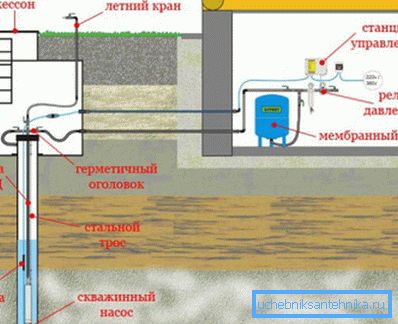
What are the wells
Water suitable for domestic use, can be extracted from 2 levels:
- The first level lies relatively not deep, it is conventionally called sandy, since the water is in the sandy layer.
- The second level is deeper and is located in a layer of limestone, such wells are called artesian wells, then we will consider in more detail.
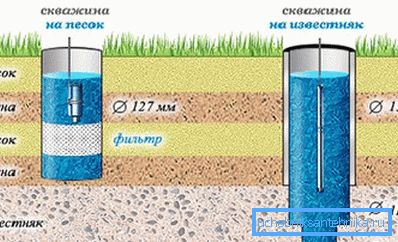
Extraction of water from the sand layer
- This type of wells is used for personal use only, since the thickness of the aquifer is on average 0.5m? at one o'clock. This is quite enough to ensure the domestic needs in the house and watering the backyard. But there will be little to ensure the needs of the dacha cooperative.
- The depth of the sandy aquifer varies on average from 10 m to 50 m. A distinctive feature here is that all the work can be done with their own hands, within a few days. Of course the work is hard, but simple and quite doable.
- The advantages of such designs.
- The price of equipment and performance of work will not be high compared with the artesian option.
- By the time the work is done quickly, you can fully finish a maximum of a week.
- Minuses.
- There is no guarantee that if the neighbors have water, it will be at the same depth at your site.
- The probability of contamination of the aquifer.
- The maximum service life is up to 15 years, in view of which it is not recommended to equip such wells directly under the house.
- Instability and floating nature of groundwater.
- Quite often, such water is suitable only for technical needs and requires the arrangement of an additional expensive filtration system.

Advice: according to building codes, it is not recommended to drill wells closer than 20 m from any potential source of pollution, local landfills, compost pits, toilets, etc.
Artesian wells
- This type of wells is the most preferred, as the water of them has high quality characteristics. But it’s impossible to drill it yourself, since the depth of such aquifers ranges from 50 m to 200 m. Plus, the limestone is quite a strong rock and it is practically impossible to drill it without using special equipment at such a depth. (See also the article Cementing Well Features.)
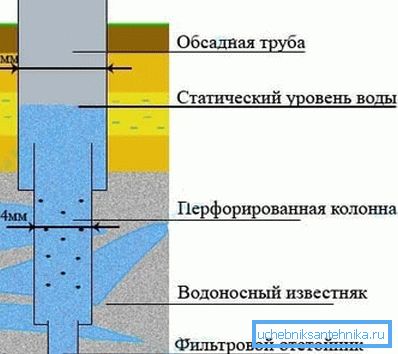
- What are good artesian wells.
- As a rule, in local geological exploration, it is possible to determine the depth of the water with relative accuracy.
- Sufficiently high water loss, the average power is 10 m? per hour, which can satisfy the needs of an average summer cottage cooperative or a large private estate with a swimming pool, several bathrooms and automatic irrigation of the garden plot.
- If you properly equip the structure, it will serve you for a long time, up to 50 years. Because of this, they can be drilled under the house.
- Stable level of occurrence of the aquifer.
- And most importantly, the quality of such water is very high. As a rule, additional filters are not required, because thanks to the limestone shell and great depth, the probability of penetration of contaminants is practically zero.
- Of the minuses, you can only indicate the high cost of arrangement. But having invested money once, you will forget about the problem of clean, drinking water for decades.
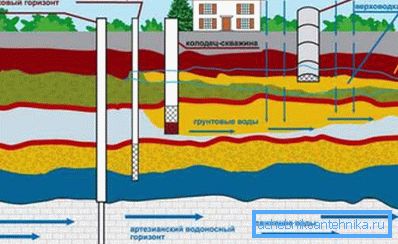
Talk about the details
Next, we will discuss how to properly equip the well. Below, we have tried to gradually present our advice on each type of work.
Casing
- Installation of casing is the first stage of the arrangement. They are designed to strengthen the walls of the well and protect the structure from collapse. The durability of the well depends on the selection of material. Pipes are steel, asbestos-cement or plastic.
- Metal pipes have high mechanical strength, which is why they are used at great depths. Among the analogs, the price is the highest. You can not save here, choosing pipes, you should pay special attention to the quality of anti-corrosion coating, as they will be operated in extreme conditions.
- You should also give preference to the threaded joint, because the weld can not provide long-term, high-quality operation in such conditions. In some cases, for economy, it makes sense to combine steel and plastic pipes. Install steel in the upper unstable formations, and install plastic on the bottom of solid stable rocks.
- Asbotsementnye pipes of sufficient quality and durable, but now used not often. The reason is that asbestos-cement material is brittle and in the case of the movement of the seams the pipe does not bend, but immediately breaks. Plus, they can be connected only by means of couplings, and with such a connection at the joints the diameter of the column decreases.
- Plastic pipes from NPVH with a threaded connection are now used everywhere. They do not rust, are environmentally neutral and the price is reasonable. The only significant disadvantage is that they are applied to a depth of 50 m, up to a maximum of 100 m and the well must be perfectly flat. Although, as mentioned earlier, for greater depths they can be combined with steel.
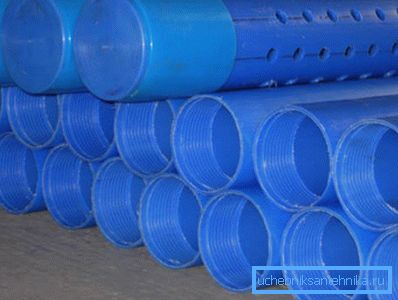
Arrangement of the caisson
Caisson is an underground well for a well.
It can be made of reinforced concrete, metal or plastic.
- Reinforced concrete caissons apply for a long time. Although they are strong enough and reliable, they have several significant flaws.
- For the transportation and installation of concrete rings requires expensive special equipment.
- It is necessary to carefully seal all seams, which is quite problematic.
- The price of concrete rings is available, but you need to additionally spend money on high-quality waterproofing.
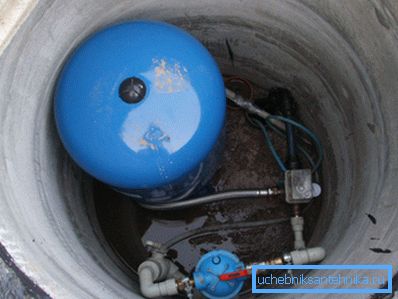
- Caissons from metal, more acceptable option. You can weld them directly at the installation site, for this purpose, sheet metal with a thickness of 4 mm or more is used. They are completely sealed, for their installation, as a rule, special equipment is also required, plus, in addition to waterproofing, metal caissons, they need thermal insulation.
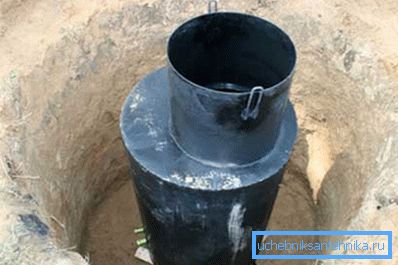
- Plastic caissons at the moment are the best option for arrangement. They are made of polyethylene, unplasticized polyvinyl chloride, polypropylene or fiberglass. Their characteristics are almost ideal: they do not rust, do not require additional warming, are completely sealed, thanks to their low weight, you can install them yourself, and most importantly, the price of such caissons is the lowest.

- Installation instructions caisson is extremely simple. Initially, digging the pit around the casing. The size of the pit should be 20-30 cm larger than the size of the caisson. The cover should rise above the ground by at least 100 mm.
- The foundation is laid according to the foundation principle.. A layer of sand is poured, a layer of rubble is placed on it, then a reinforcing structure, and all this is poured with concrete.
- A caisson is placed on the base, and the remaining space is covered with sand or soil.. But we recommend, for rigidity, install a reinforcing cage and also pour concrete.
Important: since the caisson is more designed to protect against cold, debris and weather, it makes no sense to equip it when the well is under the house.
Cap
- In a nutshell, the tip is a casing cap. A prerequisite is a hermetic connection. Save on it is not worth it, a good tip should have a folded connection, plus a rubber gasket between it and the casing.
- In addition to the protection function, the tip is a supporting structure, it is suspended from water-lifting equipment. Depending on the weight of this equipment material is selected. Plastic cap is designed for weight up to 200kg, metal withstands up to 500kg.

On the video in this article you can follow the installation process.
Pump and related equipment
- This equipment should be selected depending on the volume of water supply. Small submersible pumps of the type “Kid” or “Streamlet” are well suited for summer cottage, but they are absolutely not acceptable for autonomous systems, since it will not work to properly equip a well with their help. They work according to the vibration principle, and if the sludge vibrates, it will rise, the water quality will deteriorate, and the construction will not last for a long time.
- When a water mirror is located at a depth of 8 m, self-priming pumps are recommended. With a mirror at a depth of 15m also self-priming pumps, but with an external ejector. At a depth of 20 m, the installation of well pumps will be optimal.
- When selecting the power cable for the pump, it should be noted that, since water can be used for cooking, the insulation must be ecologically neutral. The cross section must match the engine power. Plus the cable must be designed for use under water. (See also the article Which Pump is Better for a Well: How to Choose.)
- A cable is used to lift the pump in case of damage to the lifting column. The best and proven option is a braided stainless steel cable. Galvanized cable will last up to 2 years. PVC braid slightly extend service life. But if you save on the cable, then there is a danger of irretrievably losing the pump at depth.
- Water lifting column is designed to deliver water from the depth and hold the pump. The column made of polypropylene with the obligatory hermetic threaded connection of all problematic nodes proved to be the best.
- The main pipeline is made of polypropylene or polyethylene pipes, at a depth below the ground freezing point. Pipes, without fail, must be certified for use in domestic, domestic systems, under drinking water.

Accumulator
- Hydroaccumulator or membrane tank, designed for uninterrupted water supply at home due to the accumulation of water reserves. It virtually eliminates the likelihood of a hydraulic shock in the system.
- Plus, it maintains constant pressure in the system, and the pump is forced to turn on much less frequently. Capacity of the accumulator is calculated on the basis of 50 l per 1m? water supply capacity. Available in volumes from 50 liters to 200 liters.
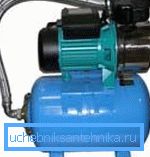
Automation
Automatic water supply system is quite simple, in particular, it includes:
- The relay controlling the operation of the pump, when the pressure drops, it turns on the pump, and when the planned pressure is reached, the relay shuts off the water supply from the well. (See also the article Features of the replacement of the pump in the well.)
- For external control of pressure in the system, a pressure gauge is installed.
- Also installed valve for automatic removal of air from the system.

It is important: when all the work on the arrangement has been completed, the water should be taken for analysis to the sanitary epidemiological station and, depending on the results of the test, decide on the additional installation of external filtration systems.
Conclusion
Now, dear reader, you have an idea about how to equip a well in the area. You can do the work yourself, but even if you decide to hire specialists, thanks to the information on our website, you can control them correctly.
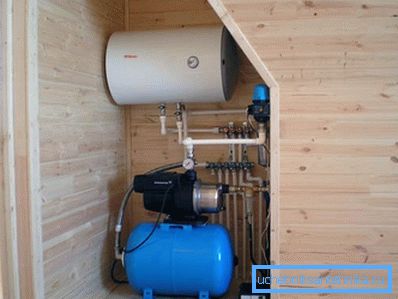
The video in this article gradually reveals one of the options for arranging the structure.